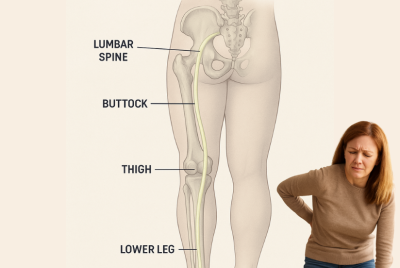How to Treat Very Painful Sciatica: Effective Relief Options for Severe Nerve Pain
When Sciatica Becomes Too Painful to Ignore
If you’ve ever experienced very painful sciatica, you know it’s not just a backache — it’s a deep, burning, and often unbearable nerve pain that can shoot from your lower back down to your foot. For some people, it’s sharp and sudden; for others, it’s constant and exhausting. In the U.S., over 40% of adults experience sciatica at some point. While mild flare-ups often fade with rest, severe sciatic nerve pain requires the right treatment plan — combining home care, lifestyle changes, and sometimes medical intervention. This article breaks down how to treat very painful sciatica, with step-by-step methods to reduce inflammation, ease muscle tension, and protect your nerve from further irritation.
How to Treat Very Painful Sciatica?
In short, combine cold and heat therapy, gentle stretches, proper posture, and anti-inflammatory foods. Stay active, manage stress, and seek medical care if pain persists or worsens. Consistency brings lasting relief.
Understanding Sciatica: Why the Pain Can Be So Intense
The sciatic nerve is the largest nerve in your body, running from your lower spine through your hips and down your legs. When it’s compressed or inflamed, it causes pain, tingling, numbness, or weakness — usually on one side of the body.
Common causes of severe sciatica include:
-
Herniated or slipped disc pressing on the nerve root
-
Spinal stenosis (narrowing of the spinal canal)
-
Piriformis syndrome (tight muscle in the buttocks compressing the nerve)
-
Arthritis or bone spurs are causing inflammation
-
Trauma or injury to the lower spine
When the nerve is pinched, your brain interprets the signals as extreme pain, even when the damage is mild. That’s what makes sciatica feel so sharp, electric, or burning — and why it can limit your ability to sit, walk, or sleep comfortably.
🩺 How to Treat Very Painful Sciatica at Home
Before reaching for medication or surgery, try these home remedies for intense sciatica to reduce inflammation and soothe your nerve naturally.
1. Alternate Ice and Heat Therapy
Ice helps reduce inflammation and numb sharp pain, while heat relaxes tight muscles and improves blood flow.
How to do it:
-
Apply an ice pack to the lower back or affected leg for 15–20 minutes.
-
After a few hours, use a heating pad or warm compress for 15 minutes.
-
Repeat this cycle 2–3 times daily.
Tip: Always place a towel between your skin and the ice/heat source to prevent burns or frostbite.
2. Gentle Stretching and Mobility Exercises
Stretching helps relieve pressure on the sciatic nerve and improves flexibility.
Best exercises for severe sciatica pain:
-
Knee-to-Chest Stretch: Loosens lower back tension.
-
Piriformis Stretch: Reduces pressure on the nerve in the buttocks.
-
Cat-Cow Stretch: Increases spine mobility and blood flow.
-
Child’s Pose: Gently lengthens the spine for relief.
👉 Start slowly and avoid bouncing or jerking movements. Consistency is more important than intensity.
3. Improve Posture to Reduce Nerve Pressure
Poor sitting or standing posture can make sciatica worse by compressing the lower spine.
Posture tips:
-
Sit with your feet flat, back straight, and shoulders relaxed.
-
Use a small lumbar pillow or rolled towel for lower back support.
-
Avoid crossing your legs or slumping on soft chairs.
Standing tip: Shift weight between your legs if standing for long periods.
4. Use Over-the-Counter Pain Relief Safely
For painful sciatica that interferes with sleep or work, over-the-counter medications can help manage inflammation.
Options include:
-
NSAIDs (ibuprofen, naproxen) to reduce swelling
-
Acetaminophen for pain control
-
Topical creams with menthol or capsaicin for localized relief
Always follow dosing instructions and check with your doctor before combining medications.
5. Massage and Foam Rolling
Massage helps release tight muscles in the lower back, glutes, and thighs — common culprits of nerve compression.
Try this:
-
Use a foam roller or tennis ball to gently roll over the glutes and hamstrings.
-
Focus on tender areas for 1–2 minutes at a time.
-
Avoid pressing directly on the spine.
You can also see a licensed massage therapist trained in neuromuscular therapy for targeted sciatica relief.
💊 Medical Options for Painful Sciatica That Won’t Go Away
If your pain persists beyond two weeks despite home care, it may be time for medical treatment. Let’s explore the best treatments for severe sciatica pain recommended by doctors in the U.S.
1. Prescription Anti-Inflammatory or Muscle Relaxants
When over-the-counter painkillers aren’t enough, your doctor may prescribe:
-
Stronger NSAIDs to reduce inflammation
-
Muscle relaxants for spasms
-
Nerve pain medications like gabapentin or pregabalin
These medications help calm irritated nerves and reduce pain signaling.
2. Epidural Steroid Injections
For sciatica pain that won’t go away, steroid injections can be a game-changer.
A corticosteroid is injected near the affected nerve root to reduce inflammation and provide relief that can last several months.
Pros:
-
Quick reduction in pain and swelling
-
Minimal recovery time
Cons:
-
Temporary relief (usually 3–6 months)
-
Limited number of injections per year
3. Physical Therapy
Physical therapists design tailored exercise programs to strengthen your core, stretch tight muscles, and improve posture.
Benefits include:
-
Better flexibility and spinal support
-
Reduced nerve compression
-
Prevention of future flare-ups
Tip: Look for a therapist experienced in treating severe sciatic nerve pain and lower back conditions.
4. Chiropractic Care and Spinal Adjustments
Chiropractic adjustments can help realign the spine, reducing pressure on the sciatic nerve.
What to expect:
-
Gentle spinal manipulation
-
Posture and mobility correction
-
Lifestyle recommendations for prevention
Some people find relief after just a few sessions, while others benefit from ongoing care.
5. Surgical Treatment (Last Resort)
Surgery is typically reserved for patients with severe, persistent pain or nerve damage that doesn’t respond to other treatments.
Common procedures include:
-
Microdiscectomy: Removes the portion of a herniated disc pressing on the nerve.
-
Laminectomy: Removes part of the bone that’s narrowing the spinal canal.
Surgery has high success rates (around 90%), but should only be considered after all non-invasive treatments have been tried.
🏠 Lifestyle Tips for Long-Term Sciatica Recovery
Healing sciatica pain takes time — but small daily habits can speed up recovery and prevent recurrence.
1. Stay Active (Don’t Stay in Bed Too Long)
Light movement encourages healing and prevents stiffness.
2. Maintain a Healthy Weight
Extra body weight increases pressure on your lower spine.
3. Eat an Anti-Inflammatory Diet
Include foods like salmon, leafy greens, turmeric, and olive oil. Avoid processed sugar, fried foods, and alcohol.
4. Sleep Smart
Use a medium-firm mattress and maintain proper spinal alignment with pillows under or between your knees.
5. Manage Stress
Chronic stress raises inflammation and muscle tension. Try deep breathing, yoga, or mindfulness meditation daily.
⚠️ When to Seek Urgent Medical Help
While most sciatica cases can be treated without surgery, contact a doctor immediately if you experience:
-
Sudden loss of bladder or bowel control
-
Severe weakness or numbness in the leg
-
Pain after a serious fall or accident
-
Progressive worsening of symptoms
These could indicate nerve compression or spinal damage requiring urgent medical care.
🧠 FAQs About How to Treat Very Painful Sciatica
1. What is the best treatment for severe sciatica pain?
Start with rest, stretching, and anti-inflammatory medications. For persistent pain, steroid injections or physical therapy may be recommended.
2. How do I stop extreme sciatic nerve pain fast?
Use cold and heat therapy alternately, practice gentle stretching, and avoid prolonged sitting. In severe cases, consult your doctor for targeted medication.
3. What causes severe sciatic pain to flare up?
Common triggers include poor posture, lifting heavy objects incorrectly, sitting for long hours, and inflammation around the lower spine.
4. Can I treat sciatica at home?
Yes, mild to moderate cases respond well to home remedies, stretching, and lifestyle changes. If pain worsens, seek medical guidance.
5. How long does severe sciatica pain last?
Most cases improve within 4–6 weeks. Chronic sciatica may require ongoing therapy or medical treatment.
6. Does walking help sciatica?
Yes, gentle walking promotes blood flow and helps loosen tight muscles that irritate the sciatic nerve.
7. What’s the best sleeping position for sciatica?
Side sleeping with a pillow between your knees or back sleeping with a pillow under your knees helps reduce nerve pressure.
Conclusion: Relief Is Possible — Start Small and Stay Consistent
Learning how to treat very painful sciatica starts with understanding that healing takes time — but consistent care can make a world of difference.
Whether you use home remedies for intense sciatica, medical options for painful sciatica, or a combination of both, remember this: movement, posture, and self-care are your best allies.
Stay patient, stay consistent, and trust that with the right approach, your body can heal — and your sciatic pain can fade into the background.
Disclaimer
This article is for informational purposes only and does not replace medical advice. Always consult your doctor or healthcare provider before starting new treatments or exercises for sciatica.






